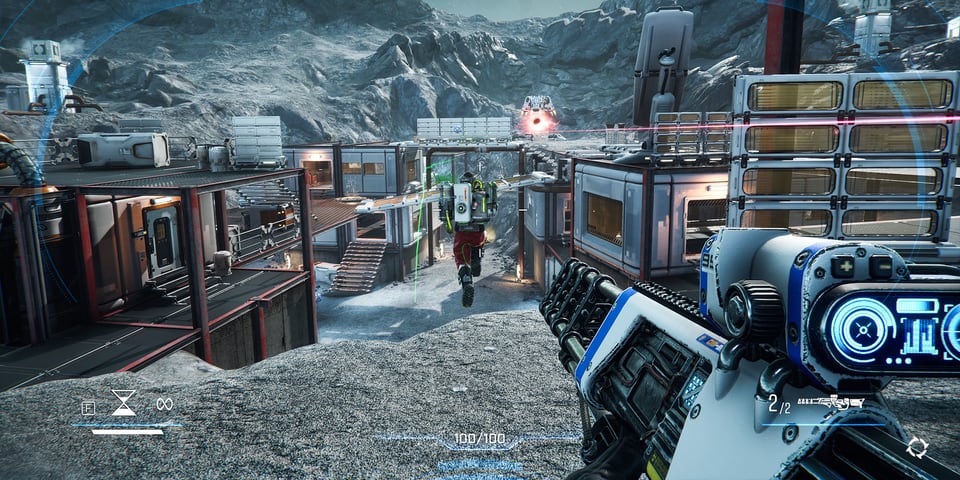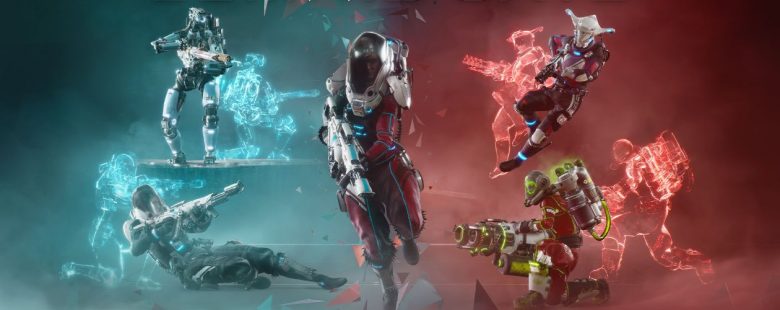Lemnis Gate is intoxicating. Lemnis Gate is excruciating. Lemnis Gate is intoxicating. Lemnis Gate is excruciating. Lemnis Gate is, much like this introduction, stuck in a contradictory time loop of emotions that mirrors its own repetitive structure. It’s a tactical multiplayer shooter that’s like playing chess, except once you see your opponent’s move you can try to make your own to counteract it before that move has even happened. It’s Groundhog Day for shooter fans, and if that sounds like your schtick, then you should get stuck in. Repeatedly.
I don’t think I’ve ever been so torn about how I feel about a game I’m reviewing. Lemnis Gate’s setup is so clever, and so unique within its genre, that your first experiences with it can’t be anything less than admiration. It immediately feels fresh. It’s so unlike its multiplayer shooter cousins that it really is capable of challenging your preconceptions about the entire online shooter cabal. Why would you ever return to Call of Duty or Battlefield when there’s something as intelligent as this out there?
The setup runs as this; each player has five opportunities of 25 seconds in length, and in that space of time your aim is to attempt to affect the objective. That objective might be to collect material and return it to your spawn point, to take control of different zones, or to attack or defend those zones. These five turns can either be plotted out simultaneously with your opponent, or turn by turn, with you watching your opponent’s go and trying to plan out your response.

The key to victory is in nullifying your opponent’s moves and safeguarding your own. If you’ve seen them run to Objective A in the previous round, you can head over that way to gun them down before they get there. Or you could just ignore them and head to Objective C on the other side of the map, planning to deal with them in a later turn. Even if you kill that enemy, their actions aren’t wiped out entirely. Your counteraction can be counteracted in turn, restoring the original victim to the timeline.
It’s insanely smart. The push and pull as you layer turn upon turn can be incredibly effective, with such a small window of opportunity requiring you to be laser-focussed on what you’re aiming to achieve in that round. Each move is often given to a subsequent counter-move, with further moves reinstating earlier runs. It can be mind-bendingly hard to keep track of, but when you do you can revel in your own mental capacity.
The issue comes when you fail to achieve your task. It’s safe to say that Lemnis Gate has an exceedingly high skill window. So high that you’re going to be better served with rocket boots than a ladder. It’s all well and good planning out a strategy, but it then relies on your physical ability to enact it with utter precision. This is far from easy, and all too often you feel like you’ve wasted a turn based purely on one missed shot, or an ill-timed leap.

Lemnis Gate has the trappings of a hero shooter lurking in its time-bending frame. There are seven operatives for you to choose from, and you can use each of them once during each half of a match. This adds a further tactical wrinkle to your time, as you have to work out who to keep in reserve, who offers you the best opening gambit, and who has the potential to completely turn the tide in the final turn.
They’re a decent bunch of sci-fi creations, but they’re nothing we haven’t come across before. Kapitan is our regular soldier, though this time she’s Russian, and a ‘she’. Her special ability is that she can throw grenades. Karl meanwhile is a robot, and while I like him, and his laser beam, he is a less amusing brother to Apex Legends‘ Pathfinder. Toxin, similarly, has a highly useful ability to poison everyone and everything – he’s become my go-to final round gambit – but we’ve seen it all before. They’re all a little bit staid and reliable, and that seems disappointing when the game’s set-up is so refreshing.
Each Operative has one special ability and one weapon, and while I appreciate the necessity for focus, and the minimal time you have to set them to work, it still feels like they could have done with something more. A second ability, a secondary fire mode, it might have just opened things up a touch further.
You can customise your characters as you progress, with new skins, emotes, and taunts becoming available, but with all your focus on what you need to do in a tight time window, it’s all a moot point. You’ll spend most of your time viewing both teams from your drone above the action anyway.

You can play Lemnis Gate in a number of different ways, from 1v1 turn-based play through to 2v2 concurrent play. You can choose which types of rounds you want to be included in your matchmaking, but it feels most natural when played in a turn-based manner. The downside of this is that it can sometimes feel a little lifeless. If you’re not playing with voice chat enabled there’s very little going on, other than you trying to remember where each of your opponent’s operatives are going to do.
For all of its uniqueness, Lemnis Gate benefits greatly from being played with friends. Teaming up as a pair or taking each other on can be wildly more amusing than playing against strangers, and I have to recommend recommend it as that. The accompaniment of all your hard work being undone by a string of friendly expletives can never be underestimated.




